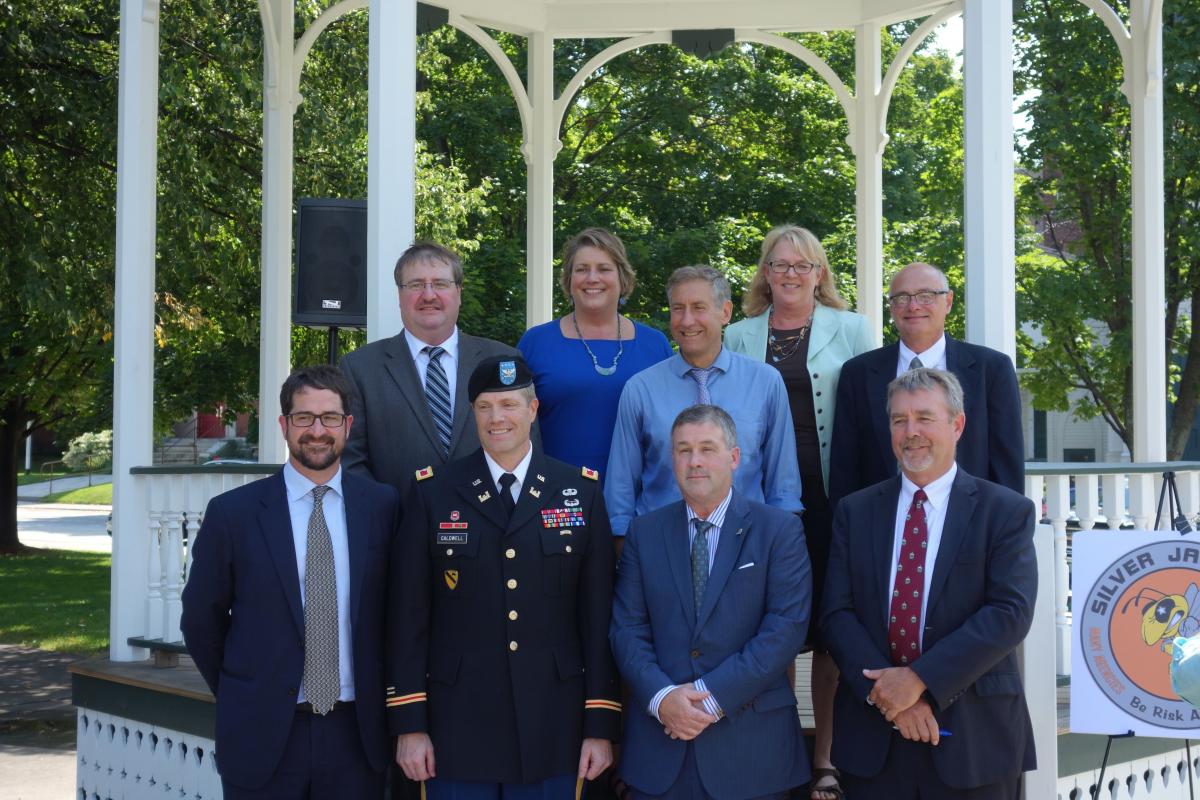
The signatories of the Silver Jackets Charter from left to right.
Back row: Richard Verville, FEMA Region 1; Patricia Moulton, Vermont Agency of Commerce & Community Development; Ben Rose, Division of Emergency Management & Homeland Security; Vicky Drew, Natural Resources Conservation Service-USDA; Keith Robinson, U.S. Geological Survey. Front row: Trey Martin, Vermont Agency of Natural Resources; Colonel David Caldwell, U.S. Army Corps of Engineers; Christopher Herrick, Division of Emergency Management & Homeland Security; Chris Cole, Vermont Agency of Transportation
Barre, Vt. -- Senior officials and congressional staff gathered today to commend the City of Barre for a comprehensive project that will limit future flood damages to its downtown businesses and residences, and to commit the support of state and federal agencies to similar projects statewide. The event at City Hall Park came five years after Tropical Storm Irene devastated many communities across Vermont. An official “Commemoration Day” proclaimed by Governor Peter Shumlin is this Sunday.
Vermont’s villages and downtowns are unique historic, economic and cultural assets. The state’s long-term economic development strategy is to support reinvestment and growth in and around Vermont’s historic centers – however, many are near rivers or lakes and vulnerable to damage from floods. Towns like Barre are rethinking how to reduce their future risk by finding ways to give these waterways a little more room to move in places where flooding has occurred again and again.
Barre City Mayor Thom Lauzon explained how the city worked with the Vermont Economic Resiliency Initiative (VERI) to create and prioritize an action plan to reduce its vulnerability to flooding impacts. The city is now prepared to act on a recommendation from that plan, and will use state and federal funding to perform a buyout of a block of at-risk homes situated along Gunners Brook. Taking these buildings out of the river’s way will break the cycle of repetitive damage from flooding that threatens Barre citizens and a thriving downtown economy.
Agency of Commerce and Community Development Secretary Pat Moulton said her agency launched the Vermont Economic Resiliency Initiative (VERI) in 2013 to help ensure Vermont remains open for business when disaster strikes.
“Flooding represents one of the most significant and costly threats to Vermont. The effects of damage to businesses, homes, roads and utilities ripple throughout all aspects of the local, regional and state economy,” said Secretary Moulton. “The good news is projects like VERI, together with $63 million in federal funding from Housing and Urban Development (HUD) and FEMA and state funds from Vermont Housing and Conservation Board (VHCB) and philanthropic organizations, helped communities and business take steps to bounce back more quickly from future floods and disasters.”
VERI is supported and funded by multiple entities, including the U.S. Economic Development Administration (EDA), the Vermont Agencies of Natural Resources and Transportation, and Regional Planning Commissions. It is a strong example of how Vermont’s communities can be more successful when they have the full support of state and federal agencies.
In a joint statement, Senator Patrick Leahy, Senator Bernie Sanders, and Congressman Peter Welch said: “After seeing the devastation caused by the 2011 floods in cities and towns throughout Vermont, we are pleased to see that our work to secure federal funding and support has advanced state and local efforts to plan ahead and make Vermont safer and more resilient in future storms.”
The state and federal agencies also signed an agreement establishing a Silver Jackets Program in Vermont. Silver Jackets is a collaboration of state, federal, and other agencies to successfully reduce the risk of flooding and other natural disasters throughout the United States and enhance response and recovery efforts when such events do occur.
Top officials from FEMA, the U.S. Army Corps, the Natural Resources Conservation Service (NRCS-USDA) and U.S. Geological Survey were at the Barre event to formally launch the new partnership. State signatories on the charter included the Agencies of Commerce and Community Development; Transportation; Natural Resources; and the Department of Public Safety.
“In addition to providing a forum for ongoing interagency communication, participation in Silver Jackets makes us eligible to compete for federal grant funding with no monetary costs to Vermont,” DEMHS Director Christopher Herrick said. “The team has hit the ground running and has already submitted an application to United States Army Corps of Engineers for funding to update the flood inundation maps for City of Montpelier.”
Across government agencies, today Vermont instituted its focus on maintaining the momentum that brought Vermonters together after Irene to recover stronger and more prepared for future floods.
For more information on the Vermont Economic Resiliency Initiative (VERI) and actions Barre has taken to reduce flood risks, view this summary packet.
For more information on the Silver Jackets Program, read the Program Mission or view Vermont’s charter signed today.
# # #
